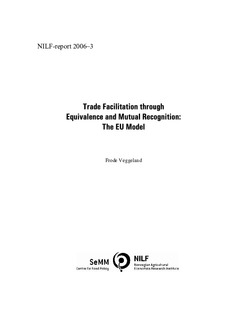| dc.contributor.author | Veggeland, Frode | |
| dc.coverage.spatial | European Union | nb_NO |
| dc.date.accessioned | 2018-04-18T10:33:48Z | |
| dc.date.available | 2018-04-18T10:33:48Z | |
| dc.date.created | 2014-01-31T12:52:15Z | |
| dc.date.issued | 2006-04 | |
| dc.identifier.isbn | 82-7077-652-1 | |
| dc.identifier.issn | 0805-7028 | |
| dc.identifier.uri | http://hdl.handle.net/11250/2494681 | |
| dc.description.abstract | This report explores how equivalence and mutual recognition have been applied by the European Union (EU) in order to facilitate trade. The EU is of particular interest in this area because it has been in the forefront internationally with regard to applying these tools, both in its internal market project and in its external trade relations. The report includes an empirical mapping of EU’s experience with applying equivalence and mutual recognition as trade facilitating tools. The aim here is to increase the understanding of how these tools can be relevant and important in a wider global context, in particular with regard to food trade. Furthermore, based on this experience some of the challenges that countries are faced with when applying these tools are highlighted thus allowing some assessments of the prospects of and difficulties in achieving trade facilitation through these means. Chapter 2 includes an account of some of the regulatory approaches that the EU has pursued in its attempts at realising an internal market, from the adoption of common rules, to mutual recognition and the «Better Regulation» programme included in the Lisbon strategy. Chapter 3 discusses EU’s rules for third-country relations. Furthermore, some of EU’s mutual recognition and equivalence agreements are explored. In addition to these, Chapter 3 includes an account of one-way judgements of equivalence included in EU’s rules for imports of organic food and fishery products. Chapter 4 presents EU’s work and positions on equivalence and mutual recognition in the WTO and the Codex Alimentarius Commission. Chapter 5 includes an assessment of the EU’s experience with mutual recognition and equivalence. Finally, in Chapter 6 some conclusions and final remarks are made. […] | nb_NO |
| dc.language.iso | eng | nb_NO |
| dc.publisher | Norsk institutt for landbruksøkonomisk forskning | nb_NO |
| dc.relation.ispartof | NILF-Report | |
| dc.relation.ispartofseries | NILF Rapport;2006-3 | |
| dc.subject | WTO | nb_NO |
| dc.subject | Den europeiske Unionen | nb_NO |
| dc.subject | The European Union | nb_NO |
| dc.title | Trade Facilitation through Equivalence and Mutual Recognition: The EU Model | nb_NO |
| dc.type | Research report | nb_NO |
| dc.description.version | publishedVersion | nb_NO |
| dc.subject.nsi | VDP::Internasjonal politikk: 243 | nb_NO |
| dc.subject.nsi | VDP::International politics: 243 | nb_NO |
| dc.source.pagenumber | 62 | nb_NO |
| dc.source.issue | 3 | nb_NO |
| dc.identifier.cristin | 1106454 | |
| dc.relation.project | Norsk institutt for landbruksøkonomisk forskning: L047 | nb_NO |
| cristin.ispublished | true | |
| cristin.fulltext | original | |
